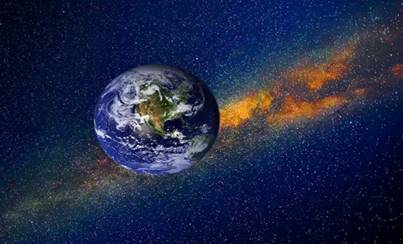
«The Age of the Earth»
Project

|
Subject: |
|
English |
|
Author of the work: |
|
Shiverskikh Amalia Semenovna |
|
Teacher: |
|
Morozova Marina Aleksandrovna |
|
Institution: |
|
School "Yaninsky" |
|
Grade: 8 |
The author of an individual project in English on the topic "The Age of the Earth" examines the history of the development and evolution of the Earth, identifies the main periods of its change, as well as the methods that exist today to determine the age of the Earth.
In her research paper and final project on determining the age of the Earth, an 8th-grade student came to the conclusion that knowing the age of the Earth helps scientists reconstruct the history of our planet, the Solar System, and understand the processes that take place in the depths of the Earth.
Contents
|
Introduction Historical periods Research results Conclusion
Introduction
Determining the age of the Earth is one of the key tasks in geology and astrophysics. Understanding the time that has passed since the formation of the Earth helps scientists better understand the processes that took place on our planet and in the Solar System as a whole. Ancient ideas: In ancient times, the concepts of the age of the Earth and the Universe did not differ. Christian theologians estimated the age of the Earth based on the Bible, usually within a few thousand years. The goal of our research paper (project) is to determine the age of the Earth. Historical periods 18th century: The first scientific estimate was given by Benoit de Maillet, who, based on geological data, obtained an estimate of 2.4 billion years. 20th century: John Perry proposed an upper estimate of 4 billion years. The discovery of radioisotope dating made it possible to date many minerals to over a billion years old. The primary method for determining the age of the Earth is radioisotope dating. Clair Patterson used the lead-lead method to date the Canyon Diablo meteorite, arriving at an estimate of 4.5 billion years. Modern data refines this age to 4.54 billion years with an error of ±1%. Patterson suggested that meteorites that formed at the same time as the solar system could be key to determining the age of the Earth. - He focused on studying iron meteorites, which contain isotopes of lead. Patterson used the radioactive decay of uranium into lead to determine the age. - Uranium-238 decays to lead-206, and uranium-235 to lead-207. Knowing the half-lives of these isotopes, the age of the sample can be calculated. |
|
Introduction
Historical periods
Research results
Conclusion
Introduction
Determining the age of the Earth is one of the key tasks in geology and astrophysics. Understanding the time that has passed since the formation of the Earth helps scientists better understand the processes that took place on our planet and in the Solar System as a whole.
Ancient ideas: In ancient times, the concepts of the age of the Earth and the Universe did not differ. Christian theologians estimated the age of the Earth based on the Bible, usually within a few thousand years.
The goal of our research paper (project) is to determine the age of the Earth.
Historical periods
18th century: The first scientific estimate was given by Benoit de Maillet, who, based on geological data, obtained an estimate of 2.4 billion years.
20th century: John Perry proposed an upper estimate of 4 billion years. The discovery of radioisotope dating made it possible to date many minerals to over a billion years old.
The primary method for determining the age of the Earth is radioisotope dating. Clair Patterson used the lead-lead method to date the Canyon Diablo meteorite, arriving at an estimate of 4.5 billion years. Modern data refines this age to 4.54 billion years with an error of ±1%.
Patterson suggested that meteorites that formed at the same time as the solar system could be key to determining the age of the Earth. - He focused on studying iron meteorites, which contain isotopes of lead.
|
|
Patterson used the radioactive decay of uranium into lead to determine the age. - Uranium-238 decays to lead-206, and uranium-235 to lead-207. Knowing the half-lives of these isotopes, the age of the sample can be calculated |
Research Results
Patterson developed precise methods for measuring lead isotopes using mass spectrometry. - He compared the ratios of lead isotopes in meteorites with the ratios in terrestrial rocks.
In 1956, Patterson published his findings: the age of the Earth is about 4.55 billion years. - This figure became generally accepted in the scientific community and remains valid today.
Determining the age of the Earth helped to better understand how the solar system formed. - Patterson's work also led to awareness of the problem of lead pollution, which influenced environmental policy and the banning of leaded gasoline.
Clair Patterson made a huge contribution to science, not only by determining the age of the Earth, but also by drawing attention to environmental issues. His methods and discoveries remain an important part of geochemistry and planetary science.
Conclusion
During the final individual project on English "Determining the Age of the Earth", 8th grade student come to the conclusion that today the age of the Earth is estimated at 4.54 billion years. This result was achieved thanks to the development of radioisotope dating and meteorite research.
Understanding the age of the Earth helps scientists reconstruct the history of our planet and the solar system, as well as better understand the processes occurring in the depths of the Earth and on its surface.

Bibliography
Паттерсон, Клэр — Википедия
Кто узнал возраст планеты Земля?: punk_lowliness — ЖЖ
Скачано с www.znanio.ru
Материалы на данной страницы взяты из открытых источников либо размещены пользователем в соответствии с договором-офертой сайта. Вы можете сообщить о нарушении.